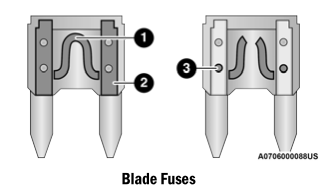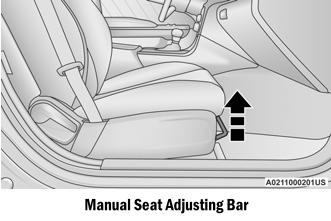Dodge Charger: VEHICLE MAINTENANCE / Fuses
WARNING!
- When replacing a blown fuse, always use an appropriate replacement fuse with the same amp rating as the original fuse. Never replace a fuse with another fuse of higher amp rating. Never replace a blown fuse with metal wires or any other material. Do not place a fuse inside a circuit breaker cavity or vice versa. Failure to use proper fuses may result in serious personal injury, fire and/or property damage.
- Before replacing a fuse, make sure that the ignition is off and that all the other services are switched off and/or disengaged.
- If the replaced fuse blows again, contact an authorized dealer.
- If a general protection fuse for safety systems (air bag system, braking system), power unit systems (engine system, trans- mission system) or steering system blows, contact an authorized dealer.
The fuses protect electrical systems against excessive current.
When a device does not work, you must check the fuse element inside the blade fuse for a break/melt.
Also, please be aware that when using power outlets for extended periods of time with the engine off may result in vehicle battery discharge.

- Fuse Element
- Blade Fuse with a good/functional fuse element
- Blade fuse with a bad/not functional fuse element (blown fuse)
 Rear Axle
Rear Axle
For normal service, periodic fluid level checks are not required. When the vehicle
is serviced for other reasons the exterior surfaces of the axle assembly should
be inspected...
 Underhood Fuses
Underhood Fuses
The Front Power Distribution Center is located in the engine compartment. This
module contains fuses and relays. Fuse cavity location and descriptions are printed
on the inside of the power distribution center cover...
Other information:
Dodge Charger 2011-2025 Owner's Manual: Daytime Running Lights (DRLs) — If Equipped
The Daytime Running Lights will turn on when the engine is started and will remain on unless the headlights are turned to the on position, the parking brake is applied, or the ignition is placed in the OFF position. NOTE: For vehicles sold in Canada, the Daytime Running Lights will automatically deactivate when the front fog lights are turned on...
Dodge Charger 2011-2025 Owner's Manual: Rolling Code Garage Door Opener Final Steps
NOTE: You have 30 seconds in which to initiate rolling code final step 2, after completing rolling code final step 1. At the garage door opener motor (in the garage), locate the “LEARN” or “TRAIN” button. This can usually be found where the hanging antenna wire is attached to the garage door opener motor...
Categories
- Manuals Home
- Dodge Charger Owners Manual
- Dodge Charger Service Manual
- Launch Control
- Automatic Door Locks — If Equipped, Child-Protection Door Lock System —Rear Doors
- Dimmer Controls
- New on site
- Most important about car
Manual Front Seat Forward/Rearward Adjustment
Some models may be equipped with a manual front passenger seat. The seat can be adjusted forward or rearward by using a bar located by the front of the seat cushion, near the floor.

Copyright © 2025 www.docharger.org
